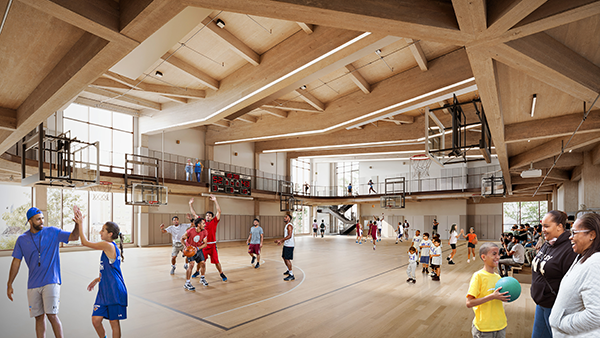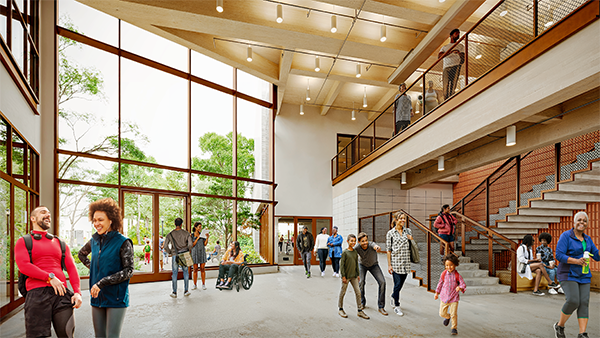The New York City Mass Timber Studio, a nine-month technical assistance accelerator for seven timber projects in preliminary planning and design, wrapped up last week with a number of participants praising its approach.
“It is a game-changer in making mass timber seem like a realistic way to move forward more smoothly” through design, procurement and construction, says Martha Bush, director with Marvel Designs, the architect for the 36,000-square-foot Walter Gladwin Recreational Center in the Bronx.
The studio was launched by the New York City Economic Development Commission and partners “to catalyze innovation and collaboration across the design and construction industry,” says Gizem Karagoz, senior project manager, NYCEDC Innovation Industries.
Bush says key to the program’s success is that New York City’s Department of Buildings (DOB) published a technical bulletin clarifying regulatory concerns around mass timber – “things that were unclear in the code.”
“Now other projects from day one will have those required clarifications so they won’t have to spin their wheels and wonder how to proceed.”
Bush says a lot of Marvel’s questions to the DOB concerned construction details because the recreational centre’s design was “quite far along.”
“It (bulletin) allowed us to finish our construction documents and the new building has been approved by the DOB.”
The bulletin, furthermore, clarifies regulatory concerns for other prime consultants such as structural engineers on mass timber projects, including details for joints/connections between mass timber, other materials and fire-protection criteria.

Another studio participant, Algoma, is working on a four-storey, 10,000-square-foot housing complex called the Prospect at Crown Heights in Brooklyn.
Company COO Seyfihan Usarer says the program assisted Algoma through “regular check-ins” with the DOB to accelerate the design process.
“If it wasn’t for the studio, the design process could be prolonged by months, which would increase the cost for the real estate developer,” Usarer says.
Karagoz says conversations between all the studio participants, the DOB and WoodWorks “were essential to navigate regulatory questions, share resources and build capacity for all stakeholders who will engage with a mass timber project across its lifecycle.”
Usarer applauds the NYCEDC for “creating more awareness of mass timber and incentivizing its usage” through the studio.
Algoma’s goal is to “create a scalable and sustainable prototype” that delivers needed housing quickly and cost-effectively in the city, he says.
The company’s feasibility studies and design projects specify mass timber in part because of its sustainability.

Usarer says the seven participating projects in New York’s five boroughs are diverse and represent more than half of all mass timber developments currently in the city.
“There is an amazing potential to create a repeatable (residential) product for the Brooklyn market,” he points out, noting with the right approach developers can cut time and costs using mass timber over conventional construction materials and designs.
Bush sees mass timber finding a place in multi-residential, institutional and public buildings such as the Gladwin Recreational Center over the next five years.
“There’s definitely a groundswell of interest in it and this studio is making it a part of the conversation.
“I don’t see a limit for the type of buildings it can be used for, unless you’re talking about our tallest buildings,” she adds.
The accelerator provided each team with grants of about $29,000 as well as technical and professional support from WoodWorks.
Bush says regulatory agencies in New York will eventually start requiring measurements for embodied carbon in buildings.
New York City aims to reduce the embodied carbon footprint of its capital construction projects 50 per cent by 2030.
“Mass timber will very quickly become part of the conversation,” says Bush.
The seven projects in the first cohort of the studio represented building typologies from mid-rise residential development to public recreational and civic buildings, says Karagoz.
“NYCEDC is excited to see all the different ways mass timber can be applied through future cohorts” of the studio.



Recent Comments
comments for this post are closed